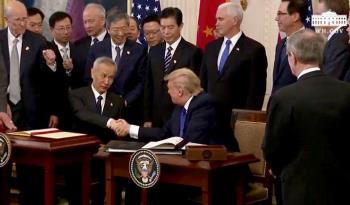 Phase-One of an presumed comprehensive trade agreement between the U.S and China was signed yesterday in Washington. The compromise followed a prolonged period of negotiations punctuated by mutual imposition of successive tariffs and alternating threats and accommodations. The questions circulating in media involve issues such as:-
Phase-One of an presumed comprehensive trade agreement between the U.S and China was signed yesterday in Washington. The compromise followed a prolonged period of negotiations punctuated by mutual imposition of successive tariffs and alternating threats and accommodations. The questions circulating in media involve issues such as:-
· Is the U.S. better off in trade relations with China following Phase-One rather than the status quo in 2017 or a comprehensive 'Grand Deal' promised by the Administration?
· Did the end result justify costs borne by farmers, manufacturers and consumers over 20 months?
· Did the Administration achieve objectives promised in pre- and post-election rhetoric?
· Which of the parties lost or gained more than their adversary?
A significant take-away from the most recent events starting with an international meeting in October 2019 and thereafter has been the difference in the tone and claims by Washington and Beijing. This is still carrying over to the events of January 15th especially with regard to agricultural imports. The White House maintains that China will purchase up to $50 million in agriculture commodities over a two -year period. The chief negotiator for China, Vice-premier Liu He stated that "agricultural purchases would not come at the expense of other nations". This implies that China will continue to import commodities in accordance with their requirements and at prevailing world prices, allowing Brazil and Argentina to compete with U.S. in supplying soybeans, the largest single commodity imported by China.
In assessing the scope of Phase-one from media disclosures, it is evident that the following provisions are included:-
Poultry Imports from the U.S.
Although the magnitude of agricultural imports is in question, it is evident that China has removed unjust restrictions on the importation of U.S. rice, chicken and dairy products. to the Politically significant corn and soybean farmers in the Midwest are apparently back to pre-2018 status only if China actually imports quantities of commodities as anticipated by the Administration. China will no longer use contrived barriers against importation and will abide by WTO and OIE regulations with respect to chicken and turkey products. Although the broiler industry appears to have scored a victory with the prospect of exporting leg quarters there is always the presumption that China may demand reciprocal import of white meat by the U.S. This is unlikely at present with ongoing African swine fever but the issue will arise when the disease is controlled and herds have been restored to 2017 levels. It is not credible that China will import egg products as the nation is more than self-sufficient, being the World's largest producer.
Imports of Merchandise from the U.S.
Beijing will increase imports of manufactured goods and purchase services by an additional $200 billion annually over the next two years, based on 2017 values.
Structural Issues
China has agreed to recognize the integrity of intellectual property. This was a long-standing and major point of contention. The Phase-One Agreement includes obligations by China but it is unknown whether the Nation will in fact abide by their commitments given a preoccupation with the Made in China 2025 initiative. Concern over compliance is the reason for the U.S to retain some tariffs as leverage. China has removed obstacles to U.S. finance and banking institutions and providers of services to allow a U.S. presence in China. The situation with regard to Huawei has yet to be resolved.
Relaxation of Tariffs
The U.S. will halve the 15 percent tariff on approximately $120 billion in imports from China. The U.S. is holding in abeyance a tariff of 15 percent on imports to the value of $156 billion due to have been introduced in mid-December 2019. A 25 percent tariff will remain on $250 billion in annual imports from China.
Dispute Resolution
China and the U.S. have agreed on procedures to resolve complaints by U.S. businesses entering into joint-venture arrangements with partners in China. China has agreed not to devalue its currency and in return the U.S. has removed China from the list of currency manipulators.
Critics note that neither subsidies to state-owned enterprises nor cybersecurity are included in the current Phase-One Agreement although these issues will be referred to the WTO. Comments on the Phase-one agreement suggest that it lacks specificity with respect to patents and intellectual property especially with regard to biologics and pharmaceuticals.
Both parties have the right to impose additional punitive tariffs in the event of non-compliance or alternatively to withdraw from the Agreement. The concordance of objectives leading to the Phase-One agreement is obviously based on mutual acceptability of the provisions negotiated at great length, requiring diplomacy, knowledge and patience on both sides.
Although the agreement was presented as being between equals, it is evident that China has made more concessions, if in fact they intend to follow through with protection of intellectual property and other structural issues that initiated the dispute. China was only induced to make changes following economic hardship arising from successive imposition of tariffs.
The Phase-One agreement is not perfect and obviously will not satisfy all stakeholders. The ink is not yet dry but already the agreement has engendered criticism influenced by political considerations. The challenge will be the next stage loosely termed Phase-Two. Although negotiations will be initiated within days of signing this first agreement, the issues are so profound to the economies of both nations that a rapid resolution is unlikely. The President has indicated that a Phase-Two agreement may only be possible after the 2020 election. This belies the 2018 declaration that "trade wars are easy to win and are short".